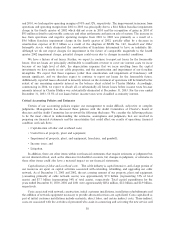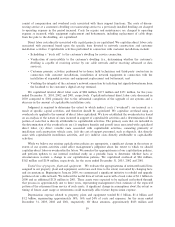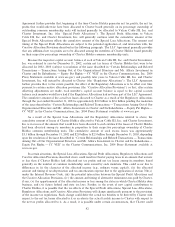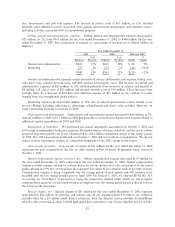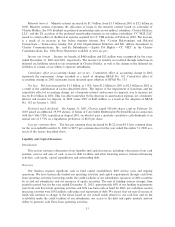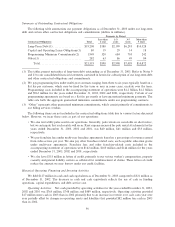Charter 2003 Annual Report Download - page 48
Download and view the complete annual report
Please find page 48 of the 2003 Charter annual report below. You can navigate through the pages in the report by either clicking on the pages listed below, or by using the keyword search tool below to find specific information within the annual report.
ended December 31, 2002, to $204 million for the year ended December 31, 2003, primarily due to an increase
in commercial high-speed data revenues.
Other revenues consist of revenues from franchise fees, equipment rental, customer installations, home
shopping, dial-up Internet service, late payment fees, wire maintenance fees and other miscellaneous revenues.
For the year ended December 31, 2003 and 2002, franchise fees represented approximately 48% and 46%,
respectively, of total other revenues. Other revenues decreased $11 million, or 3%, from $346 million for the
year ended December 31, 2002 to $335 million for the year ended December 31, 2003. The decrease was due
primarily to a decrease in franchise fees after an FCC ruling in March 2002, no longer requiring the collection
of franchise fees for high-speed data services. Franchise fee revenues are collected from customers and
remitted to franchise authorities.
The decrease in accounts receivable of 27% compared to the increase in revenues of 6% is primarily due
to the timing of collection of receivables from programmers for fees associated with the launching of their
networks coupled with our tightened credit and collections policy. These fees from programmers are not
recorded as revenue but, rather, are recorded as reductions of programming expense on a straight-line basis
over the term of the contract. Programmer receivables decreased $40 million, or 57%, from $70 million as of
December 31, 2002 to $30 million as of December 31, 2003.
Operating expenses. Operating expenses increased $145 million, or 8%, from $1.8 billion for the year
ended December 31, 2002 to $2.0 billion for the year ended December 31, 2003. Programming costs included
in the accompanying consolidated statements of operations were $1.2 billion and $1.2 billion, representing 64%
and 65% of total operating expenses for the years ended December 31, 2003 and 2002, respectively. Key
expense components as a percentage of revenues are as follows (dollars in millions):
Year Ended December 31,
2003 2002 2003 over 2002
% of % of %
Expenses Revenues Expenses Revenues Change Change
Programming ÏÏÏÏÏÏÏÏÏÏÏÏÏÏÏÏÏÏÏ $1,249 26% $1,166 26% $ 83 7%
Advertising sales ÏÏÏÏÏÏÏÏÏÏÏÏÏÏÏÏ 88 2% 87 2% 1 1%
Service ÏÏÏÏÏÏÏÏÏÏÏÏÏÏÏÏÏÏÏÏÏÏÏÏ 615 12% 554 12% 61 11%
$1,952 40% $1,807 40% $145 8%
Programming costs consist primarily of costs paid to programmers for the provision of analog, premium
and digital channels and pay-per-view programs. The increase in programming costs of $83 million, or 7%, was
due to price increases, particularly in sports programming, and due to an increased number of channels carried
on our systems, partially oÅset by decreases in analog and digital video customers. Programming costs were
oÅset by the amortization of payments received from programmers in support of launches of new channels
against programming costs of $62 million and $57 million for the year ended December 31, 2003 and 2002,
respectively.
Our cable programming costs have increased, in every year we have operated, in excess of customary
inÖationary and cost-of-living type increases, and we expect them to continue to increase due to a variety of
factors, including additional programming being provided to customers as a result of system rebuilds that
increase channel capacity, increased costs to produce or purchase cable programming and inÖationary or
negotiated annual increases. Our increasing programming costs will result in declining video product margins
to the extent we are unable to pass on cost increases to our customers. We expect to partially oÅset any
resulting margin compression from our traditional video services with revenue from advanced video services,
increased incremental high-speed data revenues, advertising revenues and commercial services revenues.
Advertising sales expenses consist of costs related to traditional advertising services provided to
advertising customers, including salaries and beneÑts and commissions. Advertising sales expenses increased
$1 million, or 1%, primarily due to increased sales commissions, taxes and beneÑts. Service costs consist
primarily of service personnel salaries and beneÑts, franchise fees, system utilities, Internet service provider
46




